
This Math Page tutorial explains how percents are ratios and then features a practice exercise.
- Subject:
- Mathematics
- Material Type:
- Lesson Plan
- Provider:
- TheMathPage
- Author:
- Lawrence Spector, PhD
- Date Added:
- 12/01/2023

This Math Page tutorial explains how percents are ratios and then features a practice exercise.

Acquire a deeper understanding of the concept of proportionality. Concise definitions, detailed examples, and an interactive worksheet to apply what you have learned.

The Math Page tutorial explains and defines ratio and proportion and includes this practice section at the end of the lesson.

This lesson teaches students how to use colored blocks to model word problems. There are several sets of problems each for addition / subtraction, multiplication / division, and ratio word problems.

This MathWords.com site lists the equations for all of the trigonometric identities.

Learn how understanding distance--both lunge distance and the distance between you and your opponent--is an important strategy in the art of fencing. This clip is from the Center for Asian American Media. In the accompanying classroom activity, students measure their own lunge distance, write and solve equations, and use ratio language to compare their numbers to that of their classmates. This resource is part of the Math at the Core: Middle School Collection. [2:21]

Math variety of concepts, this colorful website is sure to give your students the chance show what they know. Concepts covered include rounding, division with decimals, order of operations, ratio, percent, multiplication, and division of fractions, simplifying fractions, and more. Not an interactive site, but great practice activities.
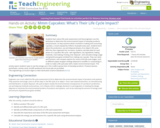
Students learn about life-cycle assessment and how engineers use this technique to determine the environmental impact of everyday products and processes. As they examine what’s involved in making and consuming cupcakes, a snack enjoyed by millions of people every year, students learn about the production, use and disposal phases of an object’s life cycle. With the class organized into six teams, students calculate data for each phase of a cupcake’s life cycle—wet ingredients, dry ingredients, baking materials, oven baking, frosting, liner disposal—and calculate energy usage and greenhouse gases emitted from making one cupcake. They use ratios and fractions, and compare options for some of the life-cycle stages, such as different paper wrapper endings (disposal to landfills or composting) in order to make a life-cycle plan with a lower environmental impact. This activity opens students’ eyes to see the energy use in the cradle-to-grave lives of everyday products. Pre/post-quizzes, worksheets, activity cards, Excel® workbook and visual aids are provided.

Using the ratio of neutrons to protons to figure out of a nucleus will be stable or radioactive. [8:20]
Khan Academy learning modules include a Community space where users can ask questions and seek help from community members. Educators should consult with their Technology administrators to determine the use of Khan Academy learning modules in their classroom. Please review materials from external sites before sharing with students.
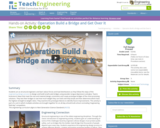
Students act as structural engineers and learn about forces and load distributions as they follow the steps of the engineering design process to design and build small-scale bridges using wooden tongue depressors and glue. Teams brainstorm ideas that meet the size and material design constraints and create prototype bridges of the most promising solutions. They test their bridges to see how much weight they can hold until they break and then determine which have the highest strength-to-weight ratios. They examine the prototype failures to identify future improvements. This activity is part of a unit in which multiple activities are brought together for an all-day school/multi-school concluding “engineering field day” competition.
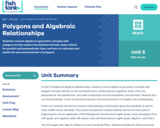
Students connect algebra to geometric concepts with polygons as they explore the distance formula, slope criteria for parallel and perpendicular lines, and learn to calculate and justify the area and perimeter of polygons.
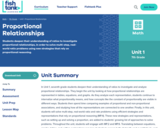
Students deepen their understanding of ratios to investigate proportional relationships, in order to solve multi-step, real-world ratio problems using new strategies that rely on proportional reasoning.

Sal solves an example problem with rates with fractions. [5:06]
Khan Academy learning modules include a Community space where users can ask questions and seek help from community members. Educators should consult with their Technology administrators to determine the use of Khan Academy learning modules in their classroom. Please review materials from external sites before sharing with students.

In this Cyberchase media gallery, learn about ratio and proportion and how to use an algebraic shortcut to solve proportion problems. In the accompanying classroom activity, students play a game called the "Pom-Pom Nose Push," in which they collect data and determine the ratio of time to distance.

Relationships among the six trigonometric functions are explored in this lesson. It is 3 of 4 in the series titled "Relationships of Trigonometric Functions." Includes short quiz. [4:46]

In this video, life-size replicas help demonstrate one-dimensional scaling and the ratio relationship between two real-world quantities. The accompanying classroom activity helps students understand how ratios and proportions can help them determine an unknown height.

This video lesson [3:38] demonstrates how to use scale factor to calculate the volume of similar figures. Students can check their understanding with an assessment.
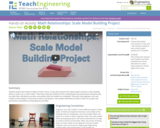
Students build scale models of objects of their choice. In class they measure the original object and pick a scale, deciding either to scale it up or scale it down. Then they create the models at home. Students give two presentations along the way, one after their calculations are done, and another after the models are completed. They learn how engineers use scale models in their designs of structures, products and systems. Two student worksheets as well as rubrics for project and presentation expectations and grading are provided.
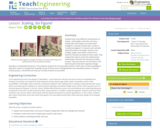
Students learn how different characteristics of shapes—side lengths, perimeter and area—change when the shapes are scaled, either enlarged or reduced. Student pairs conduct a “scaling investigation” to measure and calculate shape dimensions (rectangle, quarter circle, triangle; lengths, perimeters, areas) from a bedroom floorplan provided at three scales. They analyze their data to notice the mathematical relationships that hold true during the scaling process. They see how this can be useful in real-world situations like when engineers design wearable or implantable biosensors. This prepares students for the associated activity in which they use this knowledge to help them reduce or enlarge their drawings as part of the process of designing their own wearables products. Pre/post-activity quizzes, a worksheet and wrap-up concepts handout are provided.

Compare the cost of taking a shower with the cost of taking a bath. This interactive exercise focuses on using what you know about ratios to make a prediction about whether a shower or a bath is most cost effective and then requires completing the table to see if your prediction was accurate.